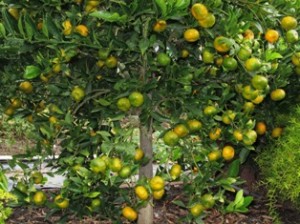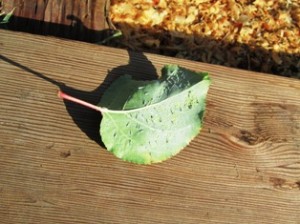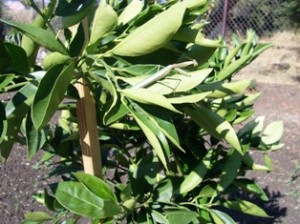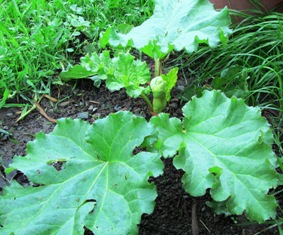Archive for the 'Pests' Category
Pest Control
A rain storm threatens to blow in over the Northern California coastline but here in the shadow of Mount Diablo, the wind is warm, the sky is blue, and the birds and bullfrogs are singing. I have to grout the kitchen counter backsplash and otherwise prepare the farmette for Thanksgiving, a goal I set at the beginning of the year. But this morning, I feel inspired to stroll through the garden to inspect my still-blooming roses, pluck and devour a strawberry or a ripe fig, or sample the mandarin oranges from the heavily laden tree. What could possibly ruin the start of such a beautiful day?
Pests, that’s what! I found colonies of aphids on the underside of the leaves still hanging onto the young apricot trees. Scrutinizing the underside of the leaves on the orange tree, I found ants inching up the trunk. That suggests to me there is a food source in the tree for those ants. So now I have deal with pests before starting the kitchen grout work.
Pests and gardens go together. I might not be able to eliminate the pests, but at least I can control them. I like an integrated control approach to dealing with pests. For example, I try not to plant all of one type of plant or tree in one area–that’s just inviting trouble in the form of pests that attack that type of plant. Also, I’ve included different varieties of the same type of plant like an apricot and a apricot/plum hybrid called an aprium tree. When I see leaves on my roses or trees with aphids, I pick the leaves off and put them in a bag (not the compost pile) to dispose of them.
My heart feels lighter when I spot a praying mantis in the garden for these amazing little creatures love to eat moths, flies, grasshoppers, crickets, and other annoying little pests. In fact, I like to introduce populations of helpful insects to compete with pest population. Green lacewings or “aphid lions” devour aphids, lots of them, but they’ll also dine on spider mites and mealybugs. Ladybugs (more correctly, “Ladybird Beetles”) are also a favorite of mine since they eat aphids, mites, and scale insects.
Spiders trap mites and pesky insects in their webs and I feel fortunate to have many in my garden. Occasionally I see those shiny black beetles known as Ground Beetles but don’t handle them because they stink. However, they can serve as a veritable hungry army against cutworms and the larvae of other pests in the garden.
I don’t like poisons or insecticides, but I will mix soap with water to spray some plants. Companion planting, or the growing of plants in close proximity for both plants’ mutual benefit, such as enhancing soil nutrients and discouraging harmful pests, is another way I control pests. So while I would love to enjoy my early morning, I think I’d better get to work on the pest problem now. The grouting can wait. There are still two days before Thanksgiving.
Hardy Rhubarb Heralds Spring
I will never forget the long and tortuous Missouri winters of my youth when for days on end the gray sky seemed to hang as low as the horizon line. With hope and great anticipation of nature’s renewal, I waited on spring. Inevitably I would notice the green shoots of tulips, grape hyacinths, and paper white narcissus pushing up through the cold earth.
Gradually, the gray lifted revealing blue. The earth warmed. The strawberries swelled and ripened. The spring peepers kept a chorus down by the pond. Then, inevitably, my grandmother would grab a basket and motion for me to join her in the garden. There we twisted and pulled thick red stalks of rhubarb–one of the earliest vegetables of spring–for pie-making. Grandma always served a dessert at every meal, even breakfast when the white icing she had slathered on just-baked cinnamon rolls would cascade down like melting snow.
So it might not come as a surprise to people who know me that when my husband and I talked about what vegetables we would include in our Henny Penny Farmette garden, I told him rhubarb for jam, jelly, and, of course, pies like my grandmother used to make. We waited until our second year here to put in the rhubarb, and we will let the plants grow for at least a year before harvesting. Next spring, we expect to be able to harvest stalks that are at least an inch thick, possibly for one to two months.
If you’ve never grown rhubarb, you need to know that rhubarb leaves are poisonous. Only the celerylike stalks, with their tart (but also sweet) flavor are used for cooking. You also won’t grow rhubarb from seed but rather from root divisions obtainable at your local nursery. Plant the root divisions (also called crowns) in holes that are about three feet deep and three feet wide and include compost and aged manure with soil. Use mulch to keep the roots moist and to protect them during a hard freeze.
I love the elephant ear-sized leaves and the red stalks (although the stalks can also be green). Best of all, the plant is easy to grow and almost pest free. My favorite variety of rhubarb is the Cherry Red because it is a prodigious producer and has an intensely sweet flavor.
 Facebook
Facebook Goodreads
Goodreads LinkedIn
LinkedIn Meera Lester
Meera Lester Twitter
Twitter








